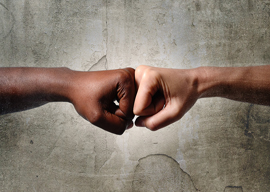
February 24, 2016

Source: Bigstock
That American whites tend to be biased in favor of blacks (at least in some situations) seems obvious, judging from a host of data points: the identity of the President of the United States, the GOP electorate’s tradition of making some random black guy such as Ben Carson or Herman Cain the presidential front-runner a few months before the Iowa caucuses, the popularity of the NFL, and the wealth piled up by Oprah Winfrey, Michael Jordan, Bill Cosby, and Will Smith.
Similarly, white people seem to feel compelled to take black meltdowns seriously, even though so many turn out to be either embarrassingly innumerate (the current Oscars whoop-de-doo) or factual fiascos (the Black Lives Matter looting in Ferguson and Baltimore).
A cynic might suggest that whites have been encouraging blacks to mau-mau them for the past half century because they find blacks colorful.
In contrast, white Americans used to take the complaints of American Indians more seriously. And indeed, Indians have much to legitimately gripe about regarding life on reservations such as Pine Ridge. But in recent years, as whites have become ever more amused by blacks, white concern for Indians has diminished. Native Americans, with their plodding dance rhythms, athletic stiffness, and lack of a gift of gab, have increasingly vanished from American consciousness. They now appear to strike whites less as noble and tragic than as depressing and tedious compared with those always entertaining blacks.
Similarly, the mounting evidence that American colleges discriminate against Asian applicants has been greeted with a collective shoulder shrug by whites. If Asians want whites to care about mistreatment, they”ll need to practice their SATs less and their slam dunks more.
One explanation for Nosek’s uncertainty about why his results are so different than expected from the orthodoxy is that these “plaques for blacks” situations like his hypothetical academic honor society are fundamentally different from real-world situations where whites would have to live (or die) with the risks of black misbehavior, such as choosing a school for their children. As we can see from the segregated public schools in the ultraliberal Upper West Side of Manhattan, when liberal whites would have to risk their children’s safety to uphold their putative racial opinions, they favor caution over ideological conformity.
There is also a relative versus absolute risk distinction that should be borne in mind. Let’s say that blacks are three times more likely than whites of the same educational level to do something very bad to the people around them on the job or in school (e.g., violence, theft, or major incompetence). (The difference in the homicide rate is almost eight times greater, but some of that is accounted for by class differences.)
Say that if you are hiring high school dropouts for jobs requiring a strong back, perhaps the chance of black hires doing something disastrous is 30% versus 10% for whites of the same class. But if you are looking at applications to an Ivy League college, possibly the ratio is the same, but at a much lower absolute level, such as 3% versus 1%.
The relative difference would be similar, but the absolute difference would be 20% in one case and 2% in the other. So maybe you drop the résumé from D”Queshawn in the circular file, but give special consideration to the college application from Darius?
This fictitious but instructive numerical example helps indicate why at the genteel levels of society, such as academic honor societies, whites treat blacks like a precious natural resource, while at the rougher levels, whites tend to view blacks as trouble waiting to happen.
In conclusion, when a researcher like Nosek is willing to defy the Repetition Crisis by honestly investigating politically incorrect explanations, he’s more likely also to sidestep the Replication Crisis as well by coming up with reproducible results.